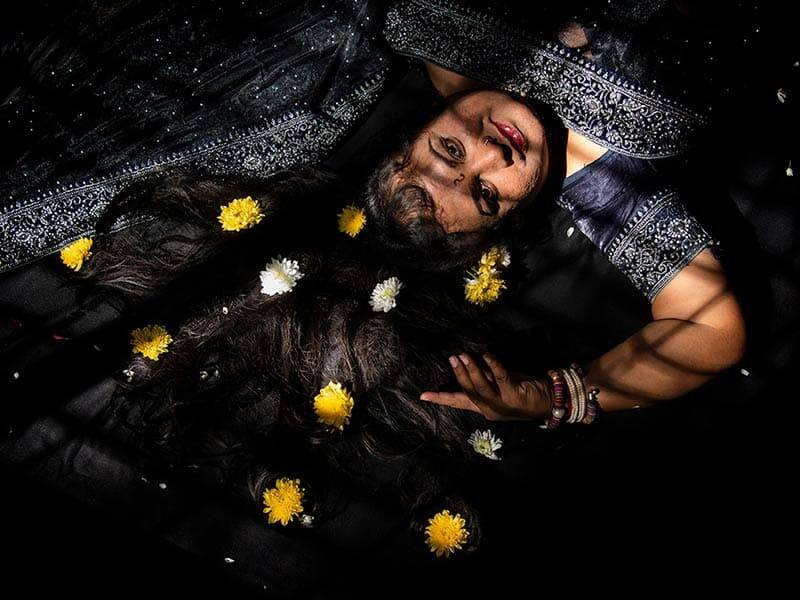From cuisine to spirituality to communal life, maize is deeply intertwined in Mexican culture. This series, by Zapotec photographer Citlali Fabián, probes and celebrates the spiritual practices and maize farming rituals of Indigenous people in the Sierra Norte region of Oaxaca. These farmers are members of AJWS partner Unión de Organizaciones de la Sierra Juárez, Oaxaca (UNOSJO), an organization which defends the culture and land rights of Zapotecs in the highlands of Oaxaca. By pairing intimate black-and-white portraits of UNOSJO farmers with colorful and highly particular images of their crop, Fabián argues for the powerful relationship between Mexican culture and land. “Maize, Seed of Life” is a testament to a way of life that is constantly under threat — and existentially important.
About the Project • Artist Statement • About UNOSJO • Photographer Bio
The Gallery

In this triptych, Fabián acknowledges that women are the keepers and teachers of the cultural and agricultural knowledge of growing maize. At left is Hildegarda’s mother Noemí Gómez, who is separating corn from the cob — an activity typically performed by women. Her quote at the center reads: “A man learns about the seasons of corn from the time he is a child. A woman learns to take care of it, to love it, to choose life — that is, the seed.”
In this moving short film, Fabián’s art comes to life as delicate illustrations are superimposed over her revealing images. Voiceovers from maize farmers — and Fabián herself — explore the importance of keeping these rituals alive in the face of their threatened existence. As one farmer says: “We practice what we remember as an example for our children.”

Over the last few years, Amalia has struggled to produce enough corn for her family. Recent drought conditions have made this particularly challenging — the unjust actuality that climate change most affects those who contribute least to it.
About the Project
“Activism Through the Artist’s Lens” is a showcase of new photographs from three communities in the Global South depicting human rights activists in brave and illuminating ways. In Mexico, the Democratic Republic of Congo and India, AJWS and Magnum Foundation paired a talented up-and-coming local photographer with one of AJWS’s human rights grantees with the directive to upend traditional art-world power dynamics by sharing creative control equally between the artist and the subject. These collaborations yielded visually arresting images that tell powerful, evocative stories, giving us precious insight into what motivates and inspires these activists, as well as an intimate glimpse into how their traditions and identities intertwine in the course of their critical work.
The Collaborators
Unión de Organizaciones de la Sierra Juarez, Oaxaca (UNOSJO) is a coalition of Indigenous peoples’ organizations in the Juárez Mountains of Oaxaca, Mexico. UNOSJO works to strengthen Indigenous communities and promote their self-determination by fostering participation in economic, social and cultural activities. They also teach youth to embrace traditional farming practices and protect their land, to sustain Indigenous heritage for future generations.
Citlali Fabián is a visual artist and storyteller from Yalalag, Mexico. She uses her photography to explore identity and its intersections with territory, migration and community. Her work has been featured in The New York Times, The Los Angeles Times, The Guardian, Buzzfeed, Remezcla, Revista Cuartoscuro and IM Magazine, among others. Fabián has also garnered solo and collective exhibitions in the U.S., Mexico, Argentina and Spain.
Artist Statement
Our hearts pump with the maize cycles,
we grow together,
we don’t exist without each other.
Mexican culture is intertwined with the development of maize (corn); it is part of our cuisine, our spirituality and the foundation of our communal life. Mexico is the birthplace of maize and is home to 64 different species, 59 of which are considered endemic. They flourish in lands considered poor in nutrients and enrich our table with their variety. Maize is our main sustenance. Its production is our way to our food sovereignty, our weapon against climate change.
This project introduces us to the spiritual approaches and farming rituals of Indigenous people in the Sierra Norte region of Oaxaca — in the villages of Tanetze, Talea and Yagallo. There, maize is part of everyday life. People look after their maize like they might look after a family member. As they say, it is the legacy of our ancestors.
With global warming, microclimates around the globe have become especially vulnerable. Each small change to the environment endangers endemic species, including maize. Every year, farmers in this region struggle, noticing how their crops produce less, and putting them in precarious conditions.
Even though native maize is known for its resilience and adaptation to different environments, the milpa can’t keep up with the speed of climate change and the intrusion of transgenic seeds. The labor of these farmers is vital to preserve the rich variety of Mexico’s ancestral and cultural product.
—Citlali Fabián
About Our Co-Sponsor
Magnum Foundation expands creativity and diversity in visual storytelling, activating new audiences and ideas through the innovative use of images. Through grants, mentorship and creative collaborations, we partner with socially engaged imagemakers exploring new models for storytelling. Since our founding in 2007 by members of the Magnum Photos cooperative, we have made more than 600 direct grants to visual storytellers from over 80 countries. To find out about upcoming exhibitions and events, learn about grant opportunities or join our community of support, please visit www.magnumfoundation.org.
Image at top of page: Evelyn’s hands are full of sustenance. More than just food, maize is central to her culture, her spirit and her society. Maize is the beating heart of Mexico and the key to establishing the sustainable, communal practices that are a necessary ingredient in providing basic human rights for all.







